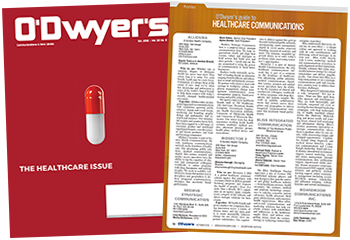 Chris Bevolo |
Those of us who’ve been hanging around hospitals and health systems for any amount of time know that marketing hasn’t always been valued or practiced in a way to drive actual revenue or business in our organizations. Of course, that’s been changing, and in our latest book, Joe Public III: The End of Hospital Marketing, we explore how leading marketing organizations in our space are driving business with their efforts, leading to the end of “hospital marketing” (the “end” meaning no longer considering hospital marketing as something lesser — less sophisticated, less progressive, less effective — than marketing in other industries).
In the book, we used the tried-and-true definition of marketing that contains the four “P’s” — product, place, price and promotion — to demonstrate how we’ve progressed in this area. It’s this last P that the vast majority of health system marketers have been focused on, and it’s the emergence of our role driving the other three that helps reflect how, finally, marketing is being more thoroughly leveraged to drive business objectives in hospitals and health systems.
For those trying to figure out the best way to help influence product, place or price as part of an organization’s marketing mix, here are potential areas of focus for these “other” Ps:
Product: marketing improves access
One of the greatest challenges facing hospitals and health systems today is access. The issues related to access are many — lack of primary care providers, limited brick and mortar entry points, clunky or non-existent virtual offerings, specialists who are six months out for the next appointment, long wait times for urgent care or ED visits. The list goes on and on. In addition, there’s a growing realization that if you want utilization for specialty care, surgical care or tertiary care — those “mid-to-bottom of the funnel” services that provide the highest financial return — health systems must pull those patients in first at the top of the funnel, through virtual care, retail care, urgent care, emergency care, and other “immediate” access points. This has led to a rapid expansion in these services across the industry, as well as innovative ways to address access through new models such as freestanding EDs or micro-hospitals.
In a number of health systems, marketing leaders are being asked to tackle the access issue. There’s a realization that to best understand access challenges and their overall impact on the organization, there must be a holistic understanding of the consumer or patient journey, and where access points play the most pivotal role. Marketers typically have the best vantage point from which to understand that journey, and to understand what, exactly, consumers desire at each point along the way.
Your “products” — in this case the health and clinical services you offer your communities — are only as strong as your customers’ ability to access them. As a marketer, you have a critical role to play in helping your organization unlock access and dramatically impact your organization’s business objectives.
Place: more consumers are “getting their care where they get their bread”
“Place” typically refers to the geographic locations or channels an organization uses to deliver its products or services. When considering employers as a marketing stakeholder, care may still be delivered in the same geographic (or virtual) locations as it is with individuals, but building direct relationships with employers represents a traditionally untapped channel for health systems. In the past few years, leading systems like Cleveland Clinic have built relationships with companies such as Lowe’s to offer customized, exclusive care delivery that is seen as a benefit to both parties. As health systems continue to explore provider-sponsored health plans, employers will take on a significant role as the primary healthcare purchaser. In some cases, health systems are expanding their direct-with-employer relationships, cutting insurance plans out of the equation altogether.
Healthcare marketers can use their expertise and data-informed approach to leverage the power of the organization’s brand and understand the needs of employers. Leading systems are dedicating marketing and sales roles to B2B customers, with some focusing marketers on employers alone. As the industry continues to morph and relationships within the sector continue to shift, marketers will have an increasingly important role in shaping how employers are yet another key “place” where services and value are delivered.
Price: how brand drives price
Often, brand power goes hand-in-hand with pricing power. Examples of this include Apple, Tesla, or Perrier — who can command a higher price than similar products due to the strong preference and loyalty consumers have for these brands.
While pricing in healthcare is certainly more complex than other industries, the pricing power of brands is still in play in our world. When consumers perceive a health system brand to be demonstrably superior to other choices they may have, they will travel further distances, deal with more difficult experiences, and otherwise incur a higher “price” to receive care at that system. While the price and cost of care at destination healthcare brands such as Cleveland Clinic, Mayo Clinic or Johns Hopkins may be higher than other health systems, the price differential does not show up to the consumer in the same way it does for Apple, Tesla or Perrier. That’s primarily because the price of healthcare is only borne by consumers in a limited way, driven in most cases by the patient’s insurance coverage. Even then, who pays the price of care is convoluted by insurance variables such as deductibles, co-pays, and co-insurance.
So where does pricing power play a role here? It impacts the negotiations health systems have with insurance plans. While payors may never admit it, there is often brand impact on payor/provider negotiations. The stronger the health system brand, the more valued and “unreplaceable” it is by employers and consumers, and the stronger negotiating power it has.
The trick, of course, is determining the value of that pricing power, and while we have yet to see anyone do this in a quantitative way, it may start by just understanding the value of a health system’s brand to start with — the financial value of brand, whether through market capitalization, stock value, M&A “goodwill” or an independent, annual brand value measurement.
No matter how you go about it, consider how you can help your organization determine the financial value of your brand. Knowing this key financial strength can be the first step in understanding the impact of your brand on payor negotiations, and, ultimately, on the “price” you’re able to set because of them.
***
Chris Bevolo is executive vice president at ReviveHealth.



 Lo Isidro, senior director at Real Chemistry with more than a decade of strategic communications and PA experience, has joined Narrative Strategies.
Lo Isidro, senior director at Real Chemistry with more than a decade of strategic communications and PA experience, has joined Narrative Strategies. Nelson Fernandez, former North American chair of APCO Worldwide and managing director of Burson-Marsteller, has joined Volunteers in Medicine Berkshires as director of communications and PA.
Nelson Fernandez, former North American chair of APCO Worldwide and managing director of Burson-Marsteller, has joined Volunteers in Medicine Berkshires as director of communications and PA. Lilit Bargar, who was most recently an EVP in the healthcare practice at Weber Shandwick, comes on board at GCI Health as EVP, corporate practice lead.
Lilit Bargar, who was most recently an EVP in the healthcare practice at Weber Shandwick, comes on board at GCI Health as EVP, corporate practice lead.
 Five ways that successful thought leaders are made.
Five ways that successful thought leaders are made.


 Have a comment? Send it to
Have a comment? Send it to 
No comments have been submitted for this story yet.